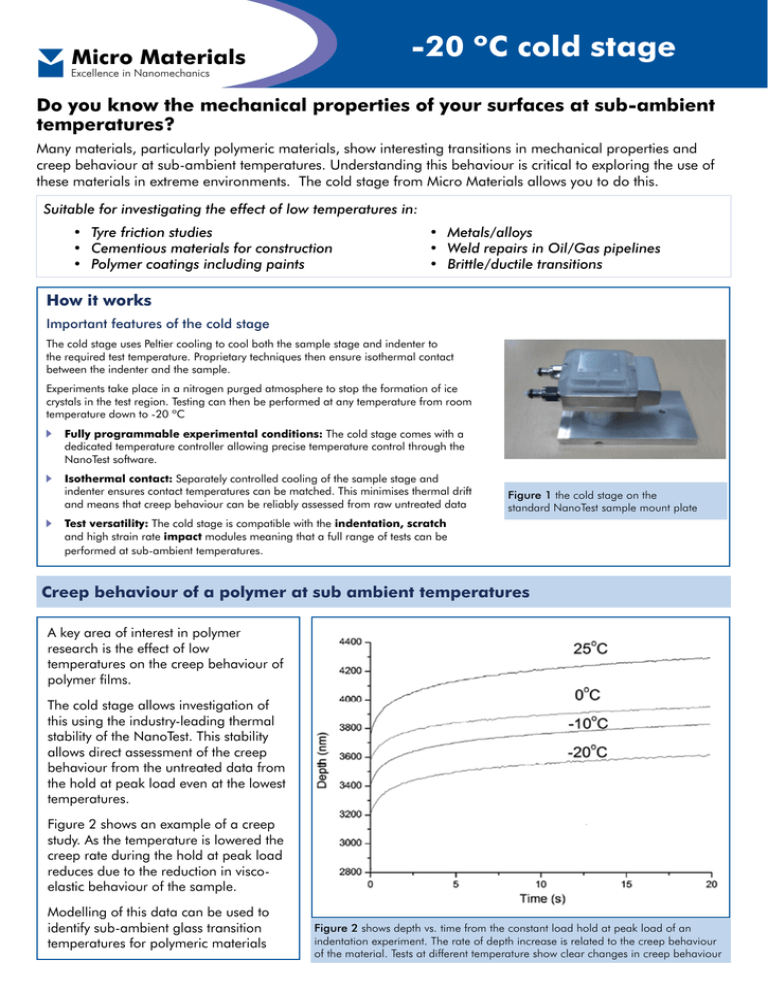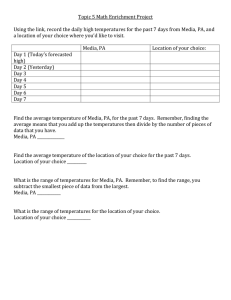-20 ºC cold stage
advertisement

-20 ºC cold stage Micro Materials Excellence in Nanomechanics Do you know the mechanical properties of your surfaces at sub-ambient temperatures? Many materials, particularly polymeric materials, show interesting transitions in mechanical properties and creep behaviour at sub-ambient temperatures. Understanding this behaviour is critical to exploring the use of these materials in extreme environments. The cold stage from Micro Materials allows you to do this. Suitable for investigating the effect of low temperatures in: • Tyre friction studies • Cementious materials for construction • Polymer coatings including paints • Metals/alloys • Weld repairs in Oil/Gas pipelines • Brittle/ductile transitions How it works Important features of the cold stage The cold stage uses Peltier cooling to cool both the sample stage and indenter to the required test temperature. Proprietary techniques then ensure isothermal contact between the indenter and the sample. Experiments take place in a nitrogen purged atmosphere to stop the formation of ice crystals in the test region. Testing can then be performed at any temperature from room temperature down to -20 ºC F ully programmable experimental conditions: The cold stage comes with a dedicated temperature controller allowing precise temperature control through the NanoTest software. I sothermal contact: Separately controlled cooling of the sample stage and indenter ensures contact temperatures can be matched. This minimises thermal drift and means that creep behaviour can be reliably assessed from raw untreated data Figure 1 the cold stage on the standard NanoTest sample mount plate T est versatility: The cold stage is compatible with the indentation, scratch and high strain rate impact modules meaning that a full range of tests can be performed at sub-ambient temperatures. Creep behaviour of a polymer at sub ambient temperatures A key area of interest in polymer research is the effect of low temperatures on the creep behaviour of polymer films. The cold stage allows investigation of this using the industry-leading thermal stability of the NanoTest. This stability allows direct assessment of the creep behaviour from the untreated data from the hold at peak load even at the lowest temperatures. Figure 2 shows an example of a creep study. As the temperature is lowered the creep rate during the hold at peak load reduces due to the reduction in viscoelastic behaviour of the sample. Modelling of this data can be used to identify sub-ambient glass transition temperatures for polymeric materials www.micromaterials.co.uk Figure 2 shows depth vs. time from the constant load hold at peak load of an indentation experiment. The rate of depth increase is related to the creep behaviour of the material. Tests at different temperature show clear changes in creep behaviour www.micromaterials.co.uk Micro Materials -20 ºC cold stage Excellence in Nanomechanics Effects of reduced temperature on a polymer nanocomposite sample The results shown in Figure 3 demonstrate the clear effect sub-ambient temperatures have on the mechanical properties of polymeric materials. In this example the ratio of hardness and modulus of both nylon and a 5% clay nylon nanocomposite is seen to increase significantly as the temperature decreases. The H/E ratio has been shown to be related to the performance of materials in sliding wear. The ability to examine the mechanical properties at relevant temperatures allows more accurate prediction of wear behaviour. Figure 3 shows the change in the ratio hardness/modulus of nylon and nylon nanocomposite samples tested from room temperature down to -10 ºC Low temperature wear of DLC coatings It is also possible to directly assess material wear behaviour by combining the cold stage and scratch test capabilities of the NanoTest. This has been done in the example shown where ramped load scratch tests have been performed on a composite DLC coating at different temperatures. Interestingly, the volume of material removed from the surface reduces as the sample is cooled. The wear track is significantly shallower at sub-ambient temperatures than at room temperature. The coating also appears more resistant to cracking at lower temperatures. This is important as it suggests that this DLC coating, often applied to improve wear resistance, will perform better in sub-ambient conditions. This could improve the usefulness of these coatings in automotive applications. Figure 4 shows the wear tracks from ramped nano-scratch experiments on a DLC coating Advantages Local MML Representative Micro Materials Ltd Willow House, Yale Business Village Ellice Way, Wrexham LL13 7YL, UK Tel: +44 1978 261615 Available for new instruments or as an upgrade Simple set up Precise temperature control down to -20 ºC Peltier cooling of sample and indenter ensure stable measurement conditions. Nitrogen purging provides moisture-free environment preventing icing Full range of tests possible within the cold stage including indentation, scratch and impact





